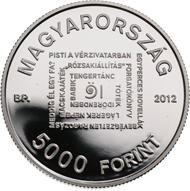May 17, 2012 – István Örkény (b. 5 April 1912, Budapest, d. 24 June 1979, Budapest) was a Kossuth award winning author, a pharmacist and the creator of world-class Hungarian grotesque prose.
Hungary / 5,000 HUF /.925 Silver / 38.61 mm / 31.46 g / Design: Vilmos Király / Mintage: 2,000 (BU), 4,000 (Proof).
In recognition of the 100th anniversary of his birth, on 5 April 2012 the Magyar Nemzeti Bank has issued a silver commemorative coin, as part of the series on Hungarian literature. On the front of the coin, the designer Vilmos Király lists Örkény’s works, placing the initials of the writer in the centre. There is a portrait of Örkény on the back.
He was born into a well-off family of pharmacists. After finishing secondary school at the Piarista Gimnázium, he enrolled to study chemistry at the Technical University, later switching over to pharmacological school, from which he graduated in 1934.
Together with his friends, he founded and edited the periodical “Keresztmetszet”, which also featured his first novella. In 1937 he met Attila József and later travelled to London and Paris, where he lived doing odd jobs. He returned to Budapest when World War II broke out, enrolling once again at the Technical University and earning a degree in chemistry in 1941.
He was sent to the Russian front in a forced-labour unit in 1942, was captured in 1943 and returned to Hungary at Christmas 1946. From then on, he abandoned his career in pharmacology and devoted his life to literature and theatre. He was the dramaturge at the Youth Theatre from 1949 and at the People’s Army Theatre from 1951. After his time in theatre, he was an editor for the publishing house Szépirodalmi Könyvkiadó in 1954. During the 1956 revolution he was a member of the executive council of the Hungarian Writers’ Association. From 1958 to 1962 he was banned from publishing due to his activities in 1956. To earn a living, he worked at the United Pharmaceutical and Nutriment Factory writing patient information leaflets.
His literary career really took off in the second half of the 1960s. This was the period when he wrote his most well-known works, including the “one-minute” stories which created an entire genre, and his philosophical satires of social life. During this period he also wrote some of his most important stage works such as “The Toth Family”, “A Mirror to the Cage” and “Catsplay”. Most of his works were performed on stage and movies were made from many. During this period, a large amount of his work was translated into foreign languages and his plays were performed around the world.
He won the Attila József Literature Award in 1955 and 1967. He won the Black Humour Award in Paris in 1969 and the Kossuth Award in 1973.
Hardly any other Hungarian writer has received so much critical acclaim for his work. His works have been continually published, and are still often performed in theatres and the constant quotations from his “one-minute” stories and thoughts show that his literary work is still very much part of modern Hungarian life.
Form more information on the coin, or to purchase them directly please visit the site of the Hungarian Mint.
Here you can read one of the One-minute stories, written in 1968: the One-minute biography.
And here is another one called Honeymooners on flypaper.






